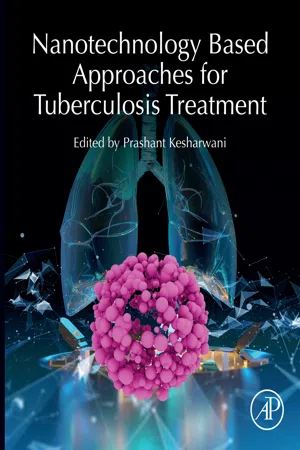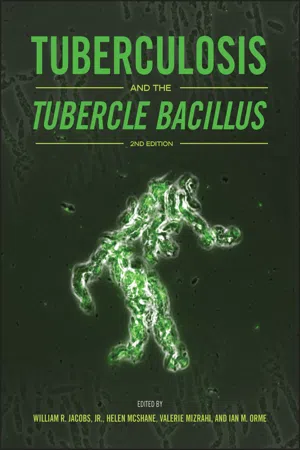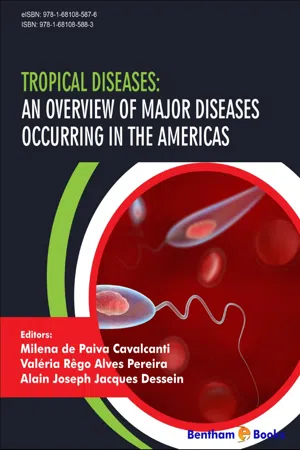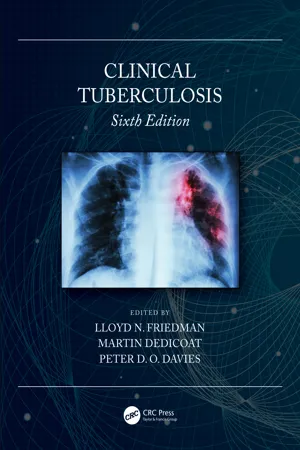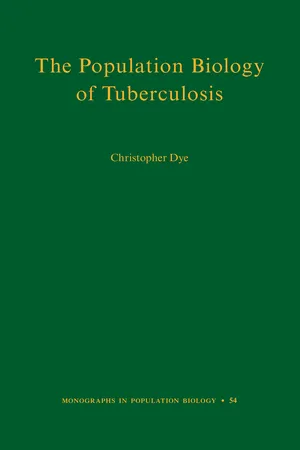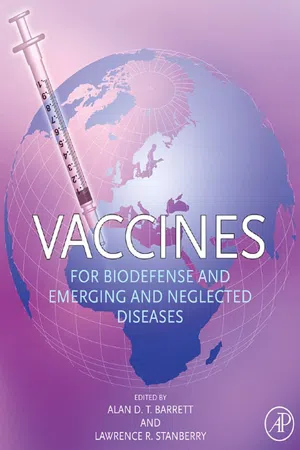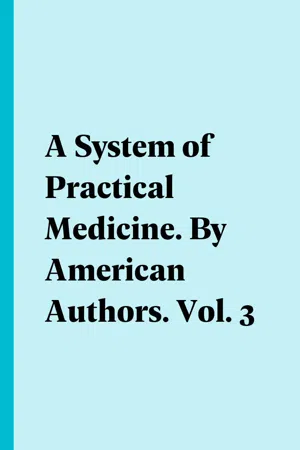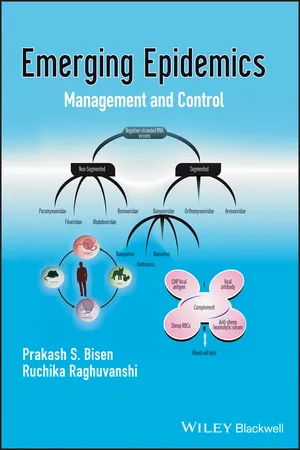Biological Sciences
Tuberculosis
Tuberculosis is a contagious bacterial infection caused by Mycobacterium tuberculosis. It primarily affects the lungs but can also affect other parts of the body. Symptoms include coughing, chest pain, weight loss, and fatigue. Tuberculosis is spread through the air when an infected person coughs or sneezes. Treatment typically involves a combination of antibiotics taken over several months.
Written by Perlego with AI-assistance
11 Key excerpts on "Tuberculosis"
- eBook - ePub
- Vanessa Gibson, David Waters, Vanessa Gibson, David Waters(Authors)
- 2016(Publication Date)
- Routledge(Publisher)
7 Tuberculosis VANESSA GIBSON AND CHRIS STENTONIntroduction Definition and classification Pathophysiology Risk factors and epidemiology Diagnosis Treatment Immunisation Public health issues ReferencesLEARNING OBJECTIVESUpon completion of this chapter the reader should be able to:INTRODUCTIONDiscuss the cause of TuberculosisProvide a definition of Tuberculosis and differentiate between the different classifications of TuberculosisIdentify risk factors for the development of TuberculosisDiscuss the treatment and prevention of the diseaseTuberculosis (TB) is one of the commonest communicable diseases in the world. The World Health Organisation (WHO) estimated that in 2014 approximately 10 million people developed TB and 1.5 million died from it (WHO, 2015a). Most of those affected live in low-income countries of Africa, Asia and South America. In several sub-Saharan African countries more than 1 in 200 people develop the disease each year. TB is second only to human immunodeficiency virus (HIV) as the world’s greatest killer from a single infectious agent (WHO, 2015b).Almost all cases of TB are contracted via the respiratory route (Public Health England [PHE], 2013). TB can spread to almost any part of the body, but this chapter will focus on pulmonary TB, which accounts for approximately 60% of cases in the United Kingdom (UK). This chapter will discuss the pathogenesis and classification of the disease. It will also discuss risk factors for contracting TB, current treatment and complications, and prevention strategies. Finally, a case study will be presented.DEFINITION AND CLASSIFICATIONTuberculosis is a bacterial infection caused by either Mycobacterium Tuberculosis (M. Tuberculosis), Mycobacterium bovis (M. bovis) or Mycobacterium africanum (M. africanum) (PHE, 2013). M. Tuberculosis is the main cause of TB in humans. M. bovis infects cattle, badgers and other wild animals, but can also infect humans, particularly those who drink unpasteurised milk from infected cattle. M. africanum is very similar to M. Tuberculosis - Prashant Kesharwani(Author)
- 2020(Publication Date)
- Academic Press(Publisher)
Chapter 1Pathogenesis, biology, and immunology of Tuberculosis
Ravi BandaruaDeviprasad SahoobRamakanta NaikbPrashant KesharwanicRambabu Dandelaaa Department of Industrial and Engineering Chemistry, Institute of Chemical Technology, Indianoil Odisha Campus, Bhubaneswar, Indiab Department of Engineering and Materials Physics, Institute of Chemical Technology, Indianoil Odisha Campus, Bhubaneswar, Indiac Department of Pharmaceutics, School of Pharmaceutical Education and Research, Jamia Hamdard (Hamdard University), New Delhi, IndiaAbstract
In this chapter, we will understand the role of Mycobacterium Tuberculosis for initiating Tuberculosis disease in human body. After a basic introduction to the mycobacteria and its scientific classification, we discussed on some general ideas about various factors, which are responsible for transmission of bacteria. Then we focused into different biological mechanisms, morphological advantages, and defense mechanisms showed by the mycobacterium in order to survive within the host cell for a very long period of time while not showing any quite symptoms of its presence. We have showcased two case studies, which provides an important evidence toward the involvement of bacteriological factors in spreading of TB epidemic. We concluded the pathogenesis section by discussing on some ongoing research topics like mycobacterium capsules, which strengthens the defense mechanisms of mycobacterium against the host cell. Then we moved to the role of immune system in controlling the Mycobacterium Tuberculosis infection. First, we explained the defenses of the upper respiratory tract that prevent the inhalation of droplets containing Mycobacterium Tuberculosis into alveoli. If the droplets manage to reach the alveoli despite the defenses of the upper respiratory tract, then innate immune system kicks in. Therefore, we explained various mechanisms of innate immune system in recognition and control of Mycobacterium Tuberculosis growth in alveoli. Then we explained the role of inflammatory responses in activating the adaptive immune responses. These adaptive immune responses control the growth of Mycobacterium Tuberculosis- eBook - ePub
- Jiri Mestecky, Michael E. Lamm, Pearay L. Ogra, Warren Strober, John Bienenstock, Jerry R. McGhee, Lloyd Mayer(Authors)
- 2005(Publication Date)
- Academic Press(Publisher)
Chapter 85 Local Immune Responses in TuberculosisJuraj Ivanyi Department of Oral Medicine & Pathology, Guy’s Campus, Medical and Dental Schools of Kings College, London, United KingdomTuberculosis (TB) has been affecting millions of people throughout the world for many centuries. Currently, it is still highly prevalent in developing countries and in the poorer and immigrant populations of advanced countries. The disease mortality is the highest of all bacterial infections, and TB has been classified by the World Health Organization (WHO) as a global emergency. This situation resulted from failures in early diagnosis, poor compliance with the protracted chemotherapy (resulting also in drug resistance), and the poor efficacy of the widely used vaccination with the bacillus Calmette-Guérin (BCG). Immunologic research is in a key position for understanding the pathogenesis of TB, and developing novel designs for effective prophylactic vaccination and possibly also immunodiagnostic tools and immunotherapeutic agents. Because the general perception of Tuberculosis is that of a lung disease, the mechanisms leading to this prominent organ predilection are of major interest. Despite numerous reviews on the immunology of TB, surprisingly, the “local” aspects, which are the purpose of this chapter, have not been reviewed comprehensively before. The lung tropism of tuberculous infection occurs also in animal experimental models, and this has been extremely beneficial for the elucidation of the cellular and molecular mechanisms in ways which would not be conceivable in humans. The immunologic mechanisms of pathogenesis are more prominent for TB than for diseases caused by other bacterial pathogens. That is because the virulence of Mycobacterium Tuberculosis (Mtb) is not caused by any overtly cytopathic constituents but rather by potent and intricate “immunomodulatory” factors, which act as “decoys” to provoke host reactions pretending to be protective, but in effect causing pathology (Ivanyi, 1986 - eBook - ePub
- William R. Jacobs, Helen McShane, Valerie Mizrahi, Ian M. Orme, William R. Jacobs, Helen McShane, Valerie Mizrahi, Ian M. Orme(Authors)
- 2017(Publication Date)
- ASM Press(Publisher)
5 Pathology of Tuberculosis: How the Pathology of Human Tuberculosis Informs and Directs Animal ModelsRandall J. Basaraba1 and Robert L. Hunter2INTRODUCTION
Progress toward developing new strategies to control the spread of Mycobacterium Tuberculosis is limited by a poor understanding of the basic pathogenesis of post-primary Tuberculosis (TB). Progress is being made in developing more rapid diagnostic assays and implementing new anti-TB drug combinations, but we are failing to answer key scientific questions that will further advance the development of new treatment and prevention strategies. In a recent statement, Dr. Anthony Fauci, head of the National Institute of Allergy and Infectious Diseases, said, “We need to better understand the delicate balance between the host and pathogen in the context of the entire biological system and this requires a radical and transformational approach.” M. Tuberculosis has coevolved with its human host for centuries. The more recent emergence of antimicrobial drug-resistant strains represents an additional challenge to controlling the global spread of TB. No new TB vaccines have been shown to be more effective than the original bacillus Calmette-Guérin (BCG) developed over 100 years ago. The development of new anti-TB drugs lags far behind the need, and prospects for host-directed therapies have validated neither targets nor biomarkers.In nature, M. Tuberculosis is a human, obligate, intracellular bacterial pathogen. While it can infect nearly any warm-blooded animal, the majority of experimentally infected laboratory animals cannot easily transmit the infection through aerosol exposure. In addition, while M. Tuberculosis infections in small animal models consistently develop the acute stages of primary TB disease, they fail to develop the late stages of post-primary disease. Post-primary TB accounts for 80% of clinical disease and nearly 100% of transmission of infection in humans, yet very little is known about the pathogenesis. Gross and histopathological examination of tissues from human patients was central to the study of TB for 150 years, from 1800 until 1950. However, the use of pathology to study TB fell out of favor as a consequence of scientific advances and changing attitudes. First, the discovery of antibiotics that were effective against M. Tuberculosis - Milena de Paiva Cavalcanti, Valéria Rêgo Alves Pereira, Alain Joseph Jacques Dessein(Authors)
- 2017(Publication Date)
- Bentham Science Publishers(Publisher)
Sputum smear microscopy and culture should be part of the clinical routine for all individuals suspected of having active TB [ 134 ]. In the near future, we will probably have new molecular and immunological methods with higher sensitivity and specificity for accurate identification of sensitive or resistant M. Tuberculosis, which can be used in the public health system. However, further studies should be performed to validate these tests in the poor and most vulnerable population. There is also a need to study the costs and benefits of these techniques in developing countries with a high burden of TB [ 118 ]. CONCLUDING REMARKS Tuberculosis continues to be an epidemic in many parts of the world and is considered a major cause of mortality by infectious diseases. Control of the spread of the disease is still a major challenge. Recently, the World Health Organization has introduced targets for the prevention and control of Tuberculosis. The strategies suggested for reducing the numbers of new cases of Tuberculosis include the development of a new vaccine that is more effective for pre- and post-exposure to M. Tuberculosis and effective treatment of latent Tuberculosis infection, as well as better diagnostics and treatment of active Tuberculosis, including reduced drug regimens. In summary, this chapter has provided a review of Tuberculosis, including the epidemiology of global Tuberculosis, the microbiology of Mycobacterium Tuberculosis and the main virulence factors, characterizing the immunological spectrum of the disease, pathogenesis and main clinical forms. It provides basic information for improving understanding of new tools for diagnosis, treatment and prevention of Tuberculosis that are being developed, which are described in the following chapters- eBook - ePub
- Lloyd N. Friedman, Martin Dedicoat, Peter D. O. Davies, Lloyd N. Friedman, Martin Dedicoat, Peter D. O. Davies(Authors)
- 2020(Publication Date)
- CRC Press(Publisher)
13 Pulmonary Tuberculosis Charles S. Dela Cruz, Barbara Seaworth, and Graham BothamleyProgressive primary Tuberculosis Post-primary TB Complications Goals of treatment Treatment regimens ReferencesProgressive primary Tuberculosis EpidemiologyPrimary Tuberculosis (TB) is the disease that occurs when there is no existing immune response to Mycobacterium Tuberculosis. These forms of TB occur, therefore, in children who have been recently exposed to an infectious case,1 , 2 in adults with immunosuppression, for example due to HIV3 and the use of anti-TNF inhibitors,4 and in the elderly where there is waning immunity.5 They may also occur in the rare and atypical forms of TB in those with deficiencies in interferon-γ and IL-12 and their receptors and pathways.6Pathogenesis (see also Chapter 4 )An infectious particle is inhaled. The size of the tubercle bacillus (2–4 × 0.2–0.5 µ m) is such that it can reach the alveolus. Early defense mechanisms such as mucus, the mucociliary escalator and cough likely remove larger infectious particles. In the alveolus, alveolar macrophages phagocytose the bacilli, which replicate within the cytoplasm (phagosome− lysosome fusion is inhibited7 ). After bursting this cell, other phagocytes enter from the blood and ingest the extracellular bacilli. This collection of cells forms the “primary focus.” As with most inhaled particles, 60% occur within the right lower lobe and 40% within the left lower lobe (Figure 13.1 ). At this stage, there are no antigen-specific immune cells and the lesion is not visible on the chest radiograph. There may be non-specific inflammation and immune responses, of which the type I interferons have been implicated in a measurable response,8 whereas the roles of lysozyme,9 defensins,10 lactoferrin,11 complement12 and natural antibodies13 are unclear. A non-specific cellular response, consisting of neutrophils, natural killer cells and γδ cells may also take part if there is sufficient inflammation. Such a collection of cells can be termed an “early” granuloma and has been seen in animal models such as the zebrafish.14 - eBook - ePub
- Christopher Dye(Author)
- 2015(Publication Date)
- Princeton University Press(Publisher)
For TB, the extent and severity of pulmonary disease is associated with infectiousness, and this alignment is used in mathematical modeling of M. Tuberculosis transmission (Chapter 2). The more effective the immune response, the slower the rate at which individuals progress to active disease, having acquired infection. Varying degrees of suppression by immune responses generate a spectrum of latent or subclinical states, ranging from the early containment of infection by an innate or an acquired immune response, through the containment of live but nonreplicating bacilli and bacterial replication at low levels partially contained by immunity (Barry et al. 2009; Young et al. 2009; Colangeli et al. 2014). Tuberculin skin testing to detect cell-mediated immune responses suggests that the human population carries a vast reservoir of live bacilli. The conventional wisdom is that, in long-term infections, the bacilli are in a quiescent or latent state, which can reactivate in any individual after years or decades of dormancy. However, as latency comes under closer scrutiny, the idea that this is a single state (Barry et al. 2009) or even that latency exists at all (Shakak et al. 2013) is under challenge (see also Chapter 2). A more contemporary view is that latent Tuberculosis—infection in the absence of clinical symptoms—is a collection of conditions that form part of a heterogeneous response to M. Tuberculosis invasion. Infection leads to the formation of distinct granulomatous lesions, with differential ability to support or suppress bacterial replication (Barry et al. 2009; Lin et al. 2013). Whatever the true nature of persistent infection, some people will develop TB months or years after first exposure. But the great majority of healthy people who have signs of exposure to infection and who presumably carry viable bacilli do not live long enough to develop TB disease. M. Tuberculosis AFFECTING THE DISTRIBUTION OF OTHER DISEASES M - Alan D.T. Barrett, Lawrence R. Stanberry(Authors)
- 2009(Publication Date)
- Academic Press(Publisher)
The preferred treatment for LTBI is 9 months of INH taken either daily or biweekly. Without DOTS, the cure rate of the biweekly regimen is worse than that of the daily regimen since a missed dose in intermittent treatment constitutes a greater percentage of total doses. Because the levels of primary INH resistance are on the rise, and because of a 0.3% rate of INH side effects, not all countries recommend treating LTBI in this way, if at all. In the United States, LTBI affects 10–15 million individuals, each with a 10% chance of progressing to TB disease without treatment; thus, in the 1950s, the U.S. Public Health Service (USPHS) Commissioned Corps began to recommend and financially support the treatment of LTBI with INH. Whether for TB disease or LTBI, cure rates are highest when treatment is administered by those experienced in the management of TB, or in consultation with someone with such experience. This is especially true for drug-resistant cases.Pathogenesis
TB Disease Process
TB vaccine development has been hampered by our lack of understanding of the details of TB pathogenesis. Protective immunity against Mtb occurs since only 8–10% of Mtb-infected individuals go on to develop TB, following exposure. However, the set of host immune responses that determine effective protection against TB disease remain an enigma.Mtb is spread in tiny aerosol droplets expelled by one person and taken up into the lung of another. Mtb finds its home in alveolar macrophages, where it prevents endosome maturation by inhibiting acidification through expression of UreC. Infected macrophages participate with other cells (see next section) in the formation of a granulomatous lesion that contains the bacteria together with host immune cells (Fig. 60.3 ). Surrounded by a fibrotic wall, the granuloma is a low-oxygen environment that forces Mtb to enter a reversible state of dormancy (Boshoff and Barry, 2005 ). Mtb respiration and metabolism are significantly diminished and growth stops. This state of dormancy, or latency from the perspective of the host, is the basis of a truce between host and pathogen where infection ensues without manifestation of clinical disease. Upon disruption of this fine balance, oxygen enters the lesion, leading to resuscitation, a molecular process of increasing metabolic and replicative activity and production of resuscitation promoting factors (Rpfs) (Downing et al., 2004 , 2005 ). Rpfs send signals to neighboring dormant bacteria, enabling them to recover. It is thought that resuscitation may lead to reactivation where high bacterial burden can develop in lesions causing caseation and cavitation of the lung. Active disease ensues with lung tissue deterioration leading to weakened lung function and bacterial dissemination to other organs.Figure 60.3- eBook - ePub
Building Resistance
Children, Tuberculosis, and the Toronto Sanatorium
- Stacie Burke(Author)
- 2018(Publication Date)
- McGill-Queen's University Press(Publisher)
Pleural Tuberculosis (or “tuberculous pleurisy,” characterized by a tuberculous pleural effusion, 45 or the accumulation of fluid in the pleural cavity 46) and tuberculous adenitis (known as “scrofula” when the cervical lymph nodes in the neck are involved), mentioned earlier in the chapter, are two of the more common extra-pulmonary forms of Tuberculosis, followed by genitourinary Tuberculosis, miliary Tuberculosis (an infection of the bloodstream, resulting from either respiratory or digestive tract infection, which can disseminate and seed various tissues and organs of the body 47), Tuberculosis of the bones and joints, and tuberculous meningitis (infection of the brain). 48 In Toronto, and North America more generally, the number of cases of extra-pulmonary forms of Tuberculosis caused by Mycobacterium bovis and the ingestion of infected cow’s milk and meat, particularly TB of the mesenteric glands (associated with the digestive tract), cervical glands (“scrofula”), and bone and joint Tuberculosis, decreased significantly with the introduction of routine cattle inspection and the pasteurization of milk (figures 4.1, 4.2). 49 Alternatively, extra-pulmonary forms of disease could arise secondary to pulmonary infection, 50 particularly when a poor host immune response (or low resistance) enabled the escape of Tuberculosis bacteria from the lungs. 51 Since the sanatorium era, more recent research has also. discovered that, in addition to variations in individual immune resistance, different infecting strains of Mycobacterium Tuberculosis can influence the site or sites of disease within the body, with some strains more likely to result in extra-pulmonary disease - eBook - ePub
A System of Practical Medicine. By American Authors. Vol. 3
Diseases of the Respiratory, Circulatory, and Hæmatopoietic Systems
- (Author)
- 2016(Publication Date)
- Perlego(Publisher)
Y JOHN S. LYNCH, M.D.Acute miliary Tuberculosis may be defined to be an acute disease characterized by an eruption in one or all of the organs of the body of small nodular or granular masses called tubercles, attended with fever and various other functional disturbances.The fact which Villemin and Klebs were the first to show,1 and which hundreds of others have since verified, that Tuberculosis can be conveyed by inoculation to certain animals, and the additional fact that Koch and his followers seem to have identified the infective material in the micro-organism which he has named bacillus Tuberculosis, would seem to justify our placing Tuberculosis, along with variola, measles, etc., among the acute contagious infectious diseases. But since some able pathologists still deny the correctness of Koch's conclusions; since in certain animals indifferent irritants have excited a disease which could not be distinguished from Tuberculosis by the ablest pathologists of Europe and America; since to some species of animals even more nearly allied to man by their organism than rabbits and guinea-pigs the disease cannot be conveyed at all, and that even to some of the latter inoculation fails to transmit it; and, above all, since there is, as far as we know, not one single case on record in which the disease has been clearly and unmistakably traced from man to man in the order of infection,—we do not think that as yet we are justified in defining it as a contagious infectious disease purely and only. Everybody will take small-pox if not protected by vaccination or inoculation, and this disease may be transmitted in a modified form to many of the lower animals. The same may be said of measles, scarlatina, and nearly all other diseases known to be contagious and infectious. Since, then, so few persons take Tuberculosis that the evidence of its contagiousness rests upon a vague popular belief, and since even some animals of a species known to be peculiarly susceptible to the disease fail to take it even by inoculation, we think that we are justified in assuming that there must be something else besides a contagium required to produce the disease. This is evidently a predisposition which depends upon some peculiar diathesis, cachexia, or dyscrasia, congenital or acquired. It has been assumed that scrofula constitutes the particular diathetic condition which predisposes to Tuberculosis, and it is common for scrofulosis and Tuberculosis to be spoken of as convertible terms. In the article on SCROFULA - eBook - ePub
Emerging Epidemics
Management and Control
- Prakash S. Bisen, Ruchika Raghuvanshi(Authors)
- 2013(Publication Date)
- Wiley-Blackwell(Publisher)
TB of the urinary system develops about 10 to 15 years after the primary infection and is, therefore, not seen in younger children. The kidneys are affected by hematogenous spread of tubercle bacilli. The infection starts between the renal pyramid and cortex and slowly progresses to the stage of caseation. With the involvement of renal pelvis, the caseous material is carried in the urine to the bladder, causing tuberculous cystitis. Initially the patients are asymptomatic. Urine may contain pus cells and on culturing may not show the growth of common urinary pathogens.Diagnosis of Tuberculosis
History and Suggestive Symptoms
Usually the patients remain asymptomatic following tuberculous infection, and it is thereby diagnosed during health check-up or pre-employment medical examination. To decide the category, previous antitubercular treatment is essential because placement in the wrong category may lead to treatment failure. Misdiagnosis also has a negative impact on TB control program in the community.Apart from these some other features should also be considered while investigating Tuberculosis patients as:- History of measles or other viral diseases in the recent past
- BCG vaccination history by checking BCG scar on left deltoid region
- Family history of TB or among adults in the neighborhood
- Associated factors as girl child, number of siblings, poverty, etc.
Sputum Microscopy
Rationale
TB affects the lungs in more than 80 percent of patients. Three sputum samples are collected and examined for the presence of acid-fast bacilli (AFB).RATIONALE FOR PRIMARY SYMPTOM
According to the Revised National Tuberculosis Control Program (RNTCP), cough for the duration of 3 weeks or longer is taken as a primary symptom for pulmonary TB. Almost 89.1 percent of patients with positive sputum smears attending health facilities can be diagnosed by screening patients with cough for duration of 2 weeks or longer (Ngadaya et al., 2009). Subjecting other patients (with cough of less than 3 weeks duration or chest pain) to sputum microscopy may increase the laboratory workload by three times, without any additional case yield. Moreover, other clinical manifestations such as fever and chest pain are also seen in other diseases and are thus not typical for diagnosis of TB.RATIONALE FOR THREE SPUTUM EXAMINATIONS
It is estimated that almost 85.8 percent of TB cases were detected with the first sputum specimen. With the second sputum specimen, the average incremental yield was 11.9 percent, whereas the incremental yield of the third specimen, when the first two specimens were negative, was 3.1 percent (Parsons et al., 2011). Additional case yield from subsequent specimens is minimal; therefore, three sputum specimens are to be examined preferentially.
Index pages curate the most relevant extracts from our library of academic textbooks. They’ve been created using an in-house natural language model (NLM), each adding context and meaning to key research topics.
Explore more topic indexes
Explore more topic indexes
1 of 6
Explore more topic indexes
1 of 4

